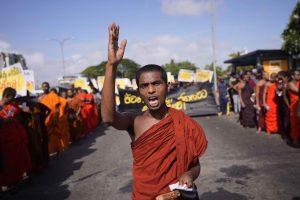2022 has been a hard year for much of South Asia. Sri Lanka has been wracked by continuous protests since late March, with Sri Lankans demanding a change in government amid a wrenching economic crisis. In Pakistan, a no-confidence vote against then-Prime Minister Imran Khan turned particularly ugly after Khan accused his opponents of conspiring against him with the United States. And Afghanistan continues to see its economy dissolve away under Taliban rule, even as the Taliban focus their attention on restricting the behavior of women in the name of public morality.
To get a more holistic view of the changes afoot in the region, The Diplomat interviewed Michael Kugelman, the deputy director of the Asia Program and senior associate for South Asia at the Wilson Center in Washington, D.C.
It’s been an eventful spring for South Asia: a change in government in Pakistan, protests demanding regime change in Sri Lanka, and a slow-moving economic disaster unfolding in Taliban-ruled Afghanistan. How much of a factor was the COVID-19 pandemic – and the resulting economic turmoil – in the political developments we’re seeing across the region right now?
I wouldn’t overstate the pandemic’s impact on political developments in South Asia. Several countries in the region have had political crises rooted in factors unrelated to the pandemic. Others have had severe economic stress not tied to the pandemic. And still others had terrible pandemic surges that didn’t result in political turbulence.
Pakistan and Sri Lanka have experienced the most political tumult, and in both cases it’s been driven by economic stress. Anti-government protests in Sri Lanka are fueled by public anger at soaring inflation. In Pakistan, the previous government was ousted in a no-confidence vote that cited economic misgovernance. But this economic stress isn’t entirely attributable to the pandemic. In Sri Lanka, two decades of economic mismanagement – from a heavy dependence on foreign loans to drastic tax cuts – had produced many years of economic fragility. The pandemic’s impact on Sri Lanka’s economy was indeed devastating – the tourism industry’s contribution to GDP fell from nearly 6 percent in 2018 to less than 1 percent in 2020. But it was the many years of bad economic decisions that made Sri Lanka’s economy so vulnerable to pandemic-induced shocks.
Pakistan, meanwhile, weathered the pandemic relatively well. You didn’t have the overwhelmed hospitals or soaring death tolls you had in India or Nepal. And the Pakistani economy did show signs of strengthening in recent months. It’s true that supply chain shortages wrought by the more recent pandemic wave have contributed to rising prices in Pakistan (and elsewhere in the region) this year, but it was the surge on global oil prices triggered by the Russian invasion of Ukraine that prompted the biggest spikes in Pakistan’s inflation.
Additionally, while the opposition’s no-confidence vote that ousted Khan was officially motivated by the issue of economic misgovernance, it was really driven by political factors more than anything else. Khan lost the support of the Army chief last November, and once that happened the opposition sensed an opportunity to pounce on Khan’s political vulnerability. That’s when it first decided to put together the no-confidence vote.
Afghanistan, meanwhile, can attribute its collapsing economy, one that has been chronically weak and dependent on foreign aid, to everything but the pandemic – Western sanctions, drought, the Taliban’s utter lack of economic governance experience, and so on. But this hasn’t caused any major political threats to the Taliban, which haven’t faced any viable political opposition since the group’s takeover last August. That said, there are some rumblings of a new resistance. There have been recent reports of fighting against the Taliban in the Panjshir region, and indications that several new armed opposition groups have formed, though they’re not potent at the moment. The Taliban could in due course face more challenges to its political control, but these would flow from non-pandemic related factors – an ever-worsening economy, surges in terrorist attacks, and its broader inability to gain domestic legitimacy.
India and Nepal were arguably the South Asian states hit hardest by the pandemic, but there haven’t been serious political tensions in either country as in Pakistan and Sri Lanka. Nepal did have a change in prime minister in the summer of 2021 at a moment when Nepal was going through a terrible pandemic surge, but that leadership transition was more tied to internal political issues. And in more recent months, political stability has returned to Nepal. In India, Prime Minister Narendra Modi’s poor handling of a catastrophic pandemic surge one year ago didn’t hurt him politically, and his party scored resounding victories in several state elections earlier this year.

































